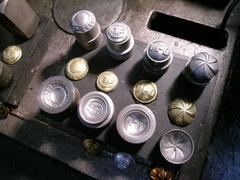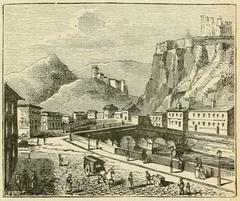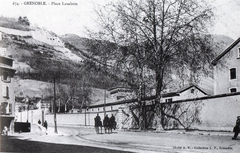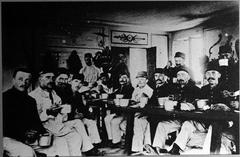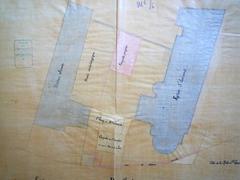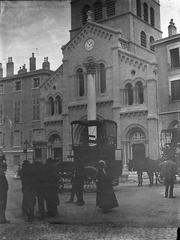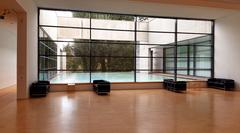Tour De Clérieu Visiting Hours, Tickets, and Guide to Grenoble Historical Sites
Date: 03/07/2025
Introduction to Tour De Clérieu in Grenoble
Nestled in the heart of southeastern France’s Dauphiné region, the Tour de Clérieu stands as a remarkable emblem of Grenoble’s medieval heritage. Built primarily during the 12th and 13th centuries and named after the influential Clérieu family, this fortified tower was a strategic defensive bastion along vital Alpine trade routes. Over the centuries, the tower played pivotal roles during significant historical events, including the French Wars of Religion and the Revolution. Today, it offers visitors a window into the past, featuring robust military architecture, thick stone walls, narrow arrow slits, and sweeping views over the Isère valley and the surrounding Vercors and Chartreuse mountain ranges.
The tower is not only a historic relic but also a cultural landmark within Grenoble’s urban landscape. Thanks to ongoing preservation efforts, contemporary visitors can appreciate its architectural grandeur and its significance in the region’s feudal and military history. The Tour de Clérieu is a compelling destination, enriched by guided tours, special events, and its proximity to other attractions such as the Bastille fortress and the Musée de Grenoble. This guide provides essential information on visiting hours, ticketing, accessibility, and transportation to ensure a rewarding experience for every traveler (snippetsofparis.com, grenoble-tourisme.com, komoot.com).
Contents Overview
- Introduction
- Medieval Origins and Architectural Evolution
- Historical Significance in Grenoble’s Defense
- The Tower During the French Wars of Religion and Revolution
- Restoration and Preservation Efforts
- Visiting the Tour de Clérieu: Practical Information
- Visiting Hours
- Ticket Information
- How to Get There
- Guided Tours and Special Events
- Accessibility
- Nearby Attractions
- Architectural Features and Styles
- Medieval Fortification and Defensive Design
- Integration with Urban and Natural Landscapes
- Evolution and Restoration
- Cultural Significance
- Symbol of Grenoble’s Historical Identity
- Educational and Interpretive Value
- Venue for Cultural Events
- Visitor Information
- Visiting Hours and Tickets
- Accessibility
- Travel Tips and Best Photographic Spots
- Visitor Experience and Interpretation
- Historical Background of the Tour De Clérieu
- Architectural Features and Preservation
- Cultural and Historical Significance
- Practical Visitor Information: Tour De Clérieu Visiting Hours & Tickets
- Access and Transportation
- Tour De Clérieu Visiting Hours
- Tour De Clérieu Tickets and Tours
- Visitor Tips
- Tour De Clérieu Among Grenoble Historical Sites and Nearby Attractions
- Comparison with Other Regional Sites
- Integration with Thematic Routes
- Local Culture and Events
- Safety, Accessibility, and Sustainability
- Frequently Asked Questions (FAQs) About Visiting Tour De Clérieu
- Visuals and Interactive Elements
- Related Articles
- Plan Your Visit Today!
Medieval Origins and Architectural Evolution
The Tour de Clérieu, dating back to the 13th century, originally formed part of Grenoble’s defensive ramparts. Its massive stone walls, narrow slit windows for archers, and elevated position overlooking the Isère River are hallmarks of medieval military engineering (snippetsofparis.com). The tower was modified over time, particularly in the 16th and 17th centuries, to adapt to evolving warfare technologies, reflecting the city’s ongoing need for robust defense (thecrazytourist.com).
Historical Significance in Grenoble’s Defense
Grenoble’s strategic location at the crossroads of Alpine trade routes made the Tour de Clérieu vital for the city’s defense, especially during conflicts with the Kingdom of Savoy and the Holy Roman Empire (1st-for-french-property.co.uk). Serving as part of a broader network of fortifications, the tower played a crucial role after Grenoble became the capital of Dauphiné in the 11th century, safeguarding the city from external threats.
The Tower During the French Wars of Religion and Revolution
Throughout the French Wars of Religion (1562–1598), the Tour de Clérieu served as a military base and refuge for Catholic forces defending Grenoble. Its commanding vantage point over the Isère and Drac rivers allowed for effective surveillance of troop movements (touristplatform.com). During the French Revolution, parts of the tower were dismantled as feudal symbols, but much of its core structure remains intact.
Restoration and Preservation Efforts
By the 19th century, the Tour de Clérieu had transitioned from military use to a cherished historical monument. Inspired by figures such as Prosper Mérimée and Eugène Viollet-le-Duc, preservation initiatives focused on stabilizing and restoring the tower (snippetsofparis.com). Recent archaeological excavations have uncovered artifacts, further illuminating the tower’s medieval history.
Visiting the Tour de Clérieu: Practical Information
Visiting Hours
- Exterior access: Year-round.
- Interior access: Typically open from 10:00 AM to 6:00 PM, April through October (subject to restoration work and events). Always check the latest information on the Grenoble Tourist Office website.
Ticket Information
- Standard admission: ~€5 for adults.
- Reductions: Discounts for students and seniors; children under 12 often free.
- Combined tickets and packages: Available for families and with other Grenoble sites.
- Purchase: Online via the official tourism portal or at the ticket office near Place Grenette.
How to Get There
Located in Grenoble’s historic center, the Tour de Clérieu is within walking distance from major landmarks such as Place Grenette and the Musée de Grenoble. Public transport serves the area well, and parking is available nearby. The cobblestone streets add to the historic ambiance (snippetsofparis.com).
Guided Tours and Special Events
Local operators offer thematic guided walks (1–2 hours) highlighting the Tour de Clérieu, sometimes using augmented reality to bring medieval Grenoble to life. The tower also participates in heritage days and local festivals—consult official channels for the latest schedules.
Accessibility
The area around the tower is pedestrian-friendly, but cobblestone streets may challenge those with mobility issues. Ramps and clear signage are provided (france.fr).
Nearby Attractions
Combine your visit with the Bastille fortress (via cable car), Cathédrale Notre-Dame, and the Musée de Grenoble. Local restaurants and artisan shops nearby offer regional specialties such as gratin dauphinois and Chartreuse liqueur (snippetsofparis.com).
Architectural Features and Styles
Medieval Fortification and Defensive Design
Constructed between the 13th and 15th centuries, the Tour de Clérieu features robust stone masonry, narrow slit windows, and a commanding position—elements characteristic of southeastern France’s military architecture (Grenoble Tourism – Architecture). Its walls, often over one meter thick, and limited access points underscore its defensive priorities.
Integration with Urban and Natural Landscapes
The tower’s strategic location offers sweeping views over Grenoble and the surrounding Alps. It echoes the city’s identity as a “gateway to the Alps” and complements other regional fortifications such as the Bastille and Fort de Comboire (Grenoble Tourism – Bastille).
Evolution and Restoration
While the core remains medieval, later adaptations introduced Renaissance and 19th-century Romantic elements. Restoration projects have preserved original stonework and stabilized the structure, ensuring its continued presence in Grenoble’s cultural landscape (Grenoble Tourism – Architecture).
Cultural Significance
Symbol of Grenoble’s Historical Identity
The Tour de Clérieu is a symbol of the city’s resilience and continuity, associated with the influential Clérieu family and celebrated in local folklore, art, and literature (Nomads Travel Guide – Grenoble).
Educational and Interpretive Value
Guided tours organized by the Grenoble Tourist Office reveal the tower’s construction, military role, and historical context, enhanced by multimedia presentations and interactive exhibits (Grenoble Tourism – Guided Tours).
Venue for Cultural Events
The tower hosts concerts, art installations, and historical reenactments, particularly during festivals like Cabaret Frappé, fostering community engagement (Grenoble Tourism – Events).
Visitor Information
Visiting Hours and Tickets
-
April to September: Tuesday–Sunday, 10:00 AM–6:00 PM
-
October to March: Wednesday–Sunday, 11:00 AM–4:00 PM
-
Closed: Mondays and public holidays
-
Ticket Prices: Adults €7, reduced €5, children under 12 free; family and group discounts available
-
Where to Buy: Grenoble Tourism website, at the site entrance, or via authorized resellers
-
COVID-19 Measures: Masks required inside, hand sanitizers at entry, social distancing on guided tours
Accessibility
Narrow staircases are typical, but handrails and virtual tour options support visitors with limited mobility.
Travel Tips and Photography
- Visit early for fewer crowds and best light.
- Capture panoramic views from the terrace at sunrise or sunset.
- Combine your visit with Grenoble’s Old Town and other historic sites.
Visitor Experience and Interpretation
Interpretive materials on-site include timelines, architectural diagrams, and archival stories. Guided tours in multiple languages cater to all ages and interests (Grenoble Tourism – Guided Tours). The Tour de Clérieu serves as a key stop on Grenoble’s heritage trails (Adventure Backpack – Grenoble Landmarks).
Historical Background of the Tour De Clérieu
Situated about 30 kilometers northwest of Grenoble, the Tour De Clérieu is the last major remnant of the former Château de Clérieu. The Clérieu family established their seat here in the 11th century, leveraging its vantage point over the valleys and trade routes. The cylindrical tower of local limestone, dating to the 12th and 13th centuries, is notable for its robust structure and defensive features (Grenoble Tourism).
Architectural Features and Preservation
Rising about 20 meters, the tower’s base is well-preserved, with original arrow slits and remnants of a spiral staircase. The upper sections, though partially ruined, offer panoramic vistas. Preservation efforts have stabilized the masonry and limited erosion. Interior access is limited, but guided tours are organized during summer and on heritage days (Komoot: Castles around Grenoble).
Cultural and Historical Significance
The tower provides insight into the feudal structure of the Dauphiné, with the Clérieu family’s fortunes mirroring regional shifts in power. Its survival highlights the importance of heritage preservation and it is often featured in local festivals and educational programs (PlanetWare: Attractions & Places to Visit in Grenoble).
Practical Visitor Information: Tour De Clérieu Visiting Hours & Tickets
Access and Transportation
About 30 km northwest of Grenoble, the tower is best reached by car, with parking in the nearby village. Public transport is limited, but regional buses and taxis, or cycling routes, offer access (HikersBay: Grenoble Tourist Information).
Visiting Hours
Open to the public during daylight hours (generally 9 AM–6 PM), with interior access mostly during guided tours or events. Check the Grenoble Tourism website for updates.
Tickets and Tours
Entry is typically free, but guided tours or special events may require tickets, available through local heritage associations or the tourist office.
Visitor Tips
- Wear sturdy shoes for uneven terrain.
- Bring sun protection in summer, warm clothes in cooler months.
- Facilities are limited; nearest cafés and restrooms are in the village.
- Sunset offers beautiful photography opportunities.
Tour De Clérieu Among Grenoble Historical Sites and Nearby Attractions
Comparison with Other Regional Sites
- Château de Vizille: Renowned for its revolutionary history and gardens (PlanetWare: Domaine de Vizille).
- Fort Barraux: A later-period fortification offering a contrast in defensive architecture (Grenoble Tourism: Autour de Grenoble).
- Parc Naturel Régional de Chartreuse and Vercors: Combine history with outdoor activities (PlanetWare: Parc Naturel Régional de Chartreuse).
Thematic Routes
The tower is featured on cycling and hiking routes around the Isère countryside and is near legendary climbs of the Tour de France (Komoot: Road Cycling Highlights).
Local Culture and Events
The area is rich in local traditions, with festivals, markets, and medieval reenactments offering immersive experiences. Local products—walnuts, cheeses, wines—can be sampled at village markets (Grenoble Tourism).
Safety, Accessibility, and Sustainability
Grenoble provides excellent safety and public services (HikersBay: Health and Safety). The Tour De Clérieu is managed sustainably, balancing visitor access with preservation. Accessibility is limited due to the historic structure and terrain, but the site can still be enjoyed by most visitors.
Frequently Asked Questions (FAQs) About Visiting Tour De Clérieu
Q1: What are the Tour De Clérieu visiting hours?
A1: Generally open from 9 AM to 6 PM; hours may vary. Check the Grenoble Tourism website for updates.
Q2: Are there entrance fees?
A2: Entry is usually free; some guided tours or events may require a ticket.
Q3: Is the tower accessible for people with mobility issues?
A3: Access is limited due to uneven terrain and historic features, but the base and surroundings are accessible to most.
Q4: How do I reach the tower from Grenoble?
A4: By car (30 km northwest), or regional bus and local taxi/cycle.
Q5: When is the best time to visit?
A5: Late spring to early autumn, when weather is pleasant and tours/events are available.
Visuals and Interactive Elements
[Add high-quality images of the Tour De Clérieu, panoramic landscape shots, and location maps. Each image should have descriptive alt tags. Interactive maps or virtual tours can be embedded to enhance engagement.]
Related Articles
Plan Your Visit Today!
Experience the rich history and scenic beauty of the Tour De Clérieu and other Grenoble landmarks. For the latest updates on visiting hours, tickets, and local events, download the Audiala app—your essential travel companion. Follow us on social media for insider tips and exclusive offers, and start planning your unforgettable journey into the heart of the Dauphiné today!
Summary and Visitor Tips for Tour De Clérieu
The Tour de Clérieu is a captivating testament to Grenoble’s heritage, blending centuries of military strategy, architectural evolution, and cultural identity. Its preserved medieval structure and panoramic vistas provide an authentic connection to the past, complemented by engaging tours, educational programs, and lively local events. Easily accessible from Grenoble, it is ideal for both casual visitors and dedicated history enthusiasts. For a smooth experience, check current opening hours and ticket information in advance. Immerse yourself in Dauphiné traditions by exploring local markets and festivals, and consider using interactive tools like the Audiala app for maps and audio guides. The Tour de Clérieu invites you to step into history and discover the resilience that defines Grenoble (grenoble-tourisme.com, snippetsofparis.com, planetware.com).
Sources and Further Reading
- Tour de Clérieu in Grenoble: Visiting Hours, Tickets & Historical Insights, 2024, Snippets of Paris (https://snippetsofparis.com/grenoble/)
- Tour De Clérieu Visiting Hours, Tickets, and History – Explore Grenoble’s Historic Tower, 2024, Grenoble Tourism (https://www.grenoble-tourisme.com/en/)
- Visiting Tour De Clérieu: Hours, Tickets & Nearby Grenoble Historical Sites, 2024, HikersBay & PlanetWare (https://www.planetware.com/tourist-attractions-/grenoble-f-rh-gren.htm)
- Visiting the Bastille Fort in Grenoble: History, Practical Information, and Tips for Visitors, 2024, Grenoble Tourist Office (https://www.grenoble-tourisme.com/en/)
- Komoot: Castles around Grenoble, 2024 (https://www.komoot.com/guide/1526711/attractions-around-grenoble)
- PlanetWare: Attractions & Places to Visit in Grenoble, 2024 (https://www.planetware.com/tourist-attractions-/grenoble-f-rh-gren.htm)
